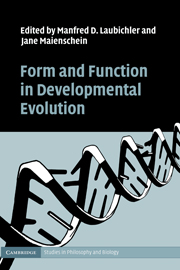Book contents
- Frontmatter
- Contents
- List of figures
- List of tables
- List of contributors
- List of journal abbreviations
- 1 Introduction
- 2 Form and function in Evo Devo: historical and conceptual reflections
- 3 Deducing plant function from organic form: challenges and pitfalls
- 4 Evolution in the light of embryos: seeking the origins of novelties in ontogeny
- 5 A focus on both form and function in examining selection versus constraint
- 6 Innovation and diversity in functional morphology
- 7 The developmental evolution of avian digit homology: an update
- 8 Functional analysis and character transformation
- 9 The nature of constraints
- 10 Toward a mechanistic Evo Devo
- Index
- References
3 - Deducing plant function from organic form: challenges and pitfalls
Published online by Cambridge University Press: 28 June 2009
- Frontmatter
- Contents
- List of figures
- List of tables
- List of contributors
- List of journal abbreviations
- 1 Introduction
- 2 Form and function in Evo Devo: historical and conceptual reflections
- 3 Deducing plant function from organic form: challenges and pitfalls
- 4 Evolution in the light of embryos: seeking the origins of novelties in ontogeny
- 5 A focus on both form and function in examining selection versus constraint
- 6 Innovation and diversity in functional morphology
- 7 The developmental evolution of avian digit homology: an update
- 8 Functional analysis and character transformation
- 9 The nature of constraints
- 10 Toward a mechanistic Evo Devo
- Index
- References
Summary
“All we know in advance when we construct a machine is the function it will have, not its structure or form.”
“We cannot use general principles to sum up historical reality any more than we can use the principles of thermodynamics to construct a Rolls-Royce.”
Eigen and Winkler (1983)INTRODUCTION
A common thread throughout the history of comparative morphology is the debate over the primacy of form versus function (Russell 1916). Does form follow function, or does function follow form? This “antithetic” argument appears to have an almost universal appeal – it recurs in the analysis of art, literature, and architecture, as well as biology, where explicit analogies with “design” are often made. Historically, some of the leading morphologists of their day had strong and divided opinions. Others saw the antithetic argument as a non-issue. Geoffroy believed that form determines function. For him, form had supremacy. In contrast, Cuvier, like Aristotle, argued that functional and structural “harmony” is essential to ecological success, without which a species would not exist. Because species obviously do exist, it logically follows that this “harmony” exists. Cuvier therefore argued strongly that structure and function had to be treated as one and inseparable. Arber too felt that the contrast between form and function ceases to exist once the word “form” is given its full biological content. However, for her, the opposition of the two concepts was the simple, albeit insidious result of a mistaken analogy between human artifacts and living things.
- Type
- Chapter
- Information
- Form and Function in Developmental Evolution , pp. 47 - 82Publisher: Cambridge University PressPrint publication year: 2009
References
- 4
- Cited by



